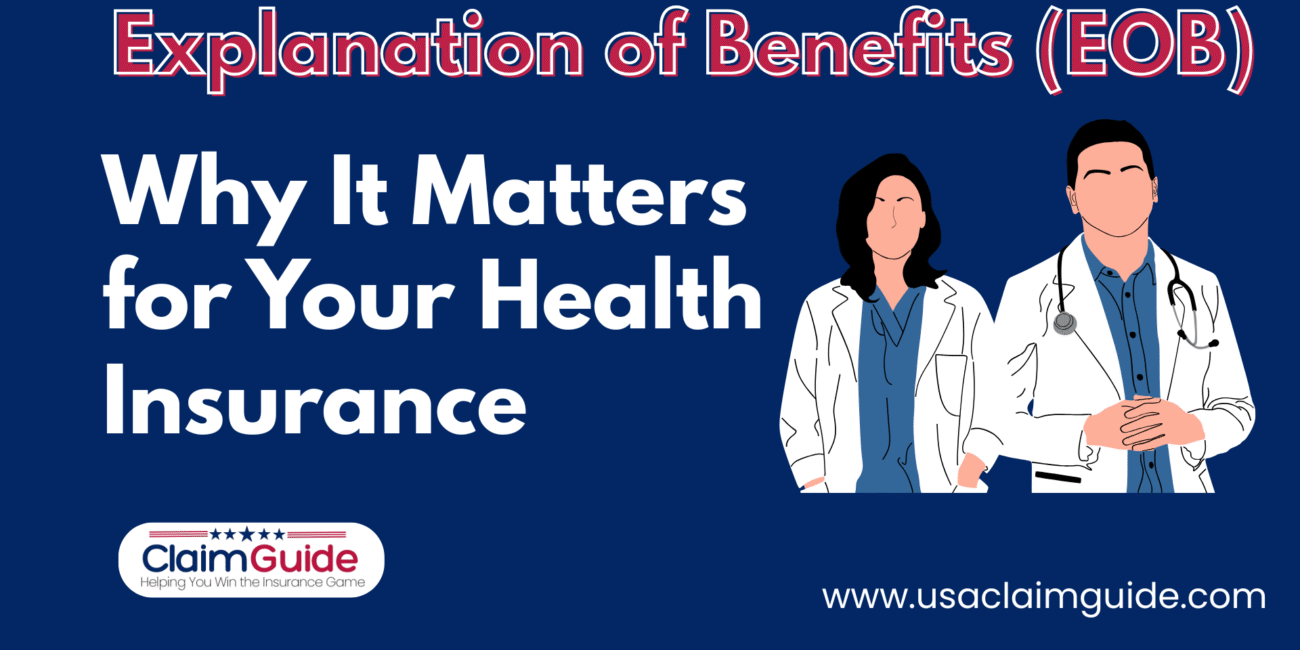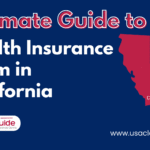If you’ve ever received a letter or digital notice from your insurance company after a doctor’s visit and wondered what it was, chances are it was an Explanation of Benefits statement from your health insurance provider. While it might seem like just another confusing document, the explanation of benefits in the U.S. health insurance system plays a vital role in helping you understand what your insurer paid, what they didn’t, and why.
In today’s healthcare environment, where out-of-pocket costs continue to rise and insurance plans become increasingly complex, knowing how to read your health insurance explanation of benefits form can help you avoid costly surprises and better manage your healthcare finances. The EOB is not a bill, but it provides essential insights into how your medical claims are processed and what you may still owe to your provider.
Understanding your EOB medical insurance statement in the U.S. is also key to catching billing mistakes, identifying overcharges, and verifying that you weren’t charged for services you didn’t receive. Whether you’re dealing with routine doctor visits, lab tests, or a major surgery, every service processed through your insurance will generate an EOB statement from your insurance company.
For individuals and families trying to navigate private insurance, Medicare, or employer-sponsored plans, learning to decode your health insurance EOB paperwork is not just helpful it’s necessary. With digital healthcare platforms becoming more common, you may now receive your explanation of benefits online through your insurance provider’s portal, making it easier than ever to access this critical document.
This article is your go-to guide for understanding the purpose of an EOB in the American healthcare system, how it impacts your out-of-pocket costs, and what you should do when you receive one. Whether you’re new to health insurance or simply looking to take more control over your healthcare expenses, this resource will give you the knowledge and confidence to make sense of your benefits.
Understanding the Explanation of Benefits (EOB) in the U.S.
When you visit a doctor, get lab work, or undergo a medical procedure in the United States, you’re likely to receive a document shortly after your appointment called an Explanation of Benefits (EOB). Many people mistake this document for a bill, but it is not. The EOB is a crucial piece of the healthcare puzzle one that informs you of how your health insurance company processed the medical claim.
In this guide, we’ll break down everything you need to know about the explanation of benefits in the U.S., from its purpose to reading it correctly and what actions to take when something looks off.
What Is an Explanation of Benefits (EOB) Form in Insurance?
An Explanation of Benefits (EOB) is a statement sent by your health insurance company after you’ve received medical services. It explains what medical treatments or services were billed, how much the provider charged, what the insurance paid, and what portion, if any, you may owe.
While it looks official and may resemble a bill it is not a bill. Instead, it’s a summary of how your insurance handled your claim.
Key Components of an Explanation of Benefits (EOB):
- Name of the patient and provider
- Description of services
- Date of service
- Charges submitted by the healthcare provider
- Amount covered by insurance
- Any discounts or negotiated rates
- Amount paid to the provider
- Your potential financial responsibility (like deductibles, co-pays, or coinsurance)
Why Is an Explanation of Benefits (EOB) Important?
The Explanation of Benefits in the U.S. plays an essential role in healthcare transparency. Here’s why it matters:
- Verification: It helps you verify that the services billed match what you actually received.
- Cost Transparency: It shows how much your insurance covered and what you may need to pay.
- Fraud Detection: Helps detect billing errors or fraud, such as services you never received.
- Financial Planning: Allows you to plan for upcoming out-of-pocket medical costs.
In today’s fast-paced healthcare environment, it’s easy to overlook the paperwork that arrives after a medical visit. But buried within those documents is something crucial your Explanation of Benefits (EOB). While it may seem like a routine notice from your insurance company, the EOB plays a much deeper role in safeguarding your finances, verifying your care, and ensuring that the healthcare system works in your favor.
One of the most overlooked benefits of the EOB is its power to expose discrepancies. Medical billing errors are more common than many realize. From duplicate charges to incorrectly coded procedures, even small mistakes can result in significant overcharges. Reviewing your EOB allows you to spot these issues early before they spiral into larger financial problems or unpaid bills.
The explanation of benefits in the U.S. also offers valuable insight into your insurance plan’s behavior. It tells you what services are considered in-network, how much your insurer actually pays providers, and how close you are to meeting your deductible. Over time, this transparency gives you a clearer picture of how your healthcare dollars are spent, allowing you to plan more strategically for future medical expenses.
Another reason the EOB matters? It’s your official record that a claim was filed. Whether you’re appealing a denied service, reconciling a bill from a provider, or checking if your Health Savings Account (HSA) qualifies for reimbursement, the EOB often serves as supporting documentation. Without it, proving what happened during a particular visit or how it was handled by your insurer can become a frustrating and time-consuming challenge.
Additionally, in a healthcare system that is often impersonal and opaque, the EOB provides something rare: visibility. It shows you the full journey of your claim from the moment your doctor submits it, to the point your insurer makes a decision. This level of detail empowers you as a patient to take control of your own health finances instead of remaining in the dark.
In short, ignoring your Explanation of Benefits isn’t just a missed opportunity it’s a risk. By paying attention to it, you put yourself in a better position to manage costs, challenge inaccuracies, and stay informed about the services you’re receiving. It’s not just about paperwork it’s about protecting your health and your wallet.
Key Reasons Why the Explanation of Benefits (EOB) Is Important
| Reason | Why It Matters | How It Helps You |
|---|---|---|
| Identifies Billing Errors | EOBs allow you to catch mistakes in medical billing or insurance claims. | You can dispute incorrect charges and avoid overpaying. |
| Tracks Insurance Coverage | Shows what services your plan covered and how much was paid. | Helps you understand your coverage limits and out-of-pocket costs. |
| Monitors Deductible Progress | Lists how much of your deductible has been met for the year. | Allows you to plan healthcare expenses more effectively. |
| Confirms Claims Were Filed | Acts as proof that your doctor submitted the claim to your insurer. | Useful if a provider claims you didn’t pay or file. |
| Supports Reimbursement or Appeals | Contains needed information if you’re disputing a denial or requesting reimbursement. | Speeds up the appeal process and strengthens your case. |
| Increases Transparency | Details each step in how your insurer handled the claim. | Builds trust and understanding in the healthcare process. |
How Your Explanation of Benefits (EOB) Can Help You
Your Explanation of Benefits can help you in several ways:
- Compare Provider Charges: Know whether you’re being overcharged or if there’s a pricing discrepancy.
- Resolve Billing Errors: Spot incorrect charges or services you never received.
- Track Deductibles: Keep tabs on how much of your deductible has been met.
- Negotiate Bills: If you owe money, the EOB gives you a clear basis for negotiating with your provider.
While often dismissed as just another insurance form, the Explanation of Benefits (EOB) can be a powerful personal tool—if you know how to use it. More than just a claim summary, your EOB acts like a personal dashboard for tracking healthcare spending, verifying insurance activity, and preparing for future costs.
One of the most practical ways your EOB helps is by giving you visibility into your true out-of-pocket spending trends. Most patients know what they’re billed by providers, but few track what insurance actually pays on their behalf. Over time, your EOBs reveal patterns how much you’re spending on specific specialists, recurring treatments, or diagnostic services. This insight can help you budget smarter, compare provider costs, or even reevaluate your health plan during open enrollment.
Another benefit? Preventing unexpected bills. The EOB often arrives before the provider’s invoice, and if you notice a service listed as “not covered” or “denied,” you can take action early. That might mean contacting your insurance company to clarify a coding issue, reaching out to your provider to resubmit the claim, or simply preparing to appeal. Without reviewing your EOB, you could be blindsided by bills you assumed were handled.
For individuals with chronic conditions or families with frequent medical visits, the EOB acts as a running financial log. It tracks everything from the number of visits to cumulative insurance payments, helping you stay informed and ready to challenge any discrepancies in future statements or coverage denials.
Even when no problems are present, your EOB is still useful. It gives you a timestamped receipt that shows the claim was processed, what was approved, and what portion (if any) remains your responsibility. If you contribute to a Health Savings Account (HSA) or Flexible Spending Account (FSA), you may need this documentation to validate eligible expenses for tax purposes.
Lastly, your EOB can assist you in making more value-based decisions about your care. When you notice a wide difference in reimbursement between similar services, it may guide you to choose providers that are in-network or more insurance-friendly. Over time, this awareness reduces the financial friction of receiving care.
In essence, your explanation of benefits in the U.S. healthcare system isn’t just a record it’s a resource. By understanding what it shows and taking the time to review it regularly, you become an informed healthcare consumer with the tools to protect both your health and your finances.

What Is the Purpose of the Explanation of Benefits?
The primary purpose of the EOB is to provide transparency and accountability between the insured, the insurer, and the healthcare provider. It documents:
- What was billed
- What the insurance covered
- How benefits were applied
- What, if any, amount you owe
This level of detail ensures there’s a paper trail and protects both patients and insurance providers.
Also Read: Ultimate Guide to Health Insurance claim in California for 2025: Costs, Plans, Rules & More
Sample Explanation of Benefits (EOB)
A typical EOB may look something like this:
| Service Date | Provider | Service Description | Charges | Insurance Paid | You Owe |
|---|---|---|---|---|---|
| 05/02/2025 | ABC Clinic | Office Visit | $200.00 | $140.00 | $20.00 (co-pay), $40.00 (your responsibility) |
Note: A sample like this helps you visualize how an EOB breaks down costs and payments.
When you receive your Explanation of Benefits (EOB) after a doctor’s appointment or medical procedure, the layout might feel intimidating at first glance. However, most insurance companies follow a relatively consistent format. Getting familiar with a sample EOB can help you understand how to interpret the details line by line without confusion or second-guessing.
🧾 A Realistic Walkthrough of an EOB Sample
A typical EOB from a U.S. health insurance provider is not a bill, but it’s usually formatted like a financial report or receipt. It’s designed to show how your claim was processed and what your financial responsibility is if any.
Here’s what you might find on a sample Explanation of Benefits:
| EOB Section | What It Typically Includes |
|---|---|
| Patient Information | Your name, member ID, date of birth, and the name of the policyholder (if different). |
| Provider Details | The name and location of the doctor, hospital, or medical facility that rendered the service. |
| Claim Number & Date | A unique tracking number for the claim, plus the date it was processed. |
| Service Description | A brief summary of the service(s) provided (e.g., “office visit,” “X-ray,” “lab work”). |
| Billed Amount | The total cost submitted by the provider before any discounts or insurance adjustments. |
| Allowed Amount | The amount your insurer agrees is reasonable and covered under your plan. |
| Amount Paid by Insurance | What your insurance company actually paid the provider. |
| Your Responsibility | What you may still owe (copayment, deductible, coinsurance). |
| Reason Codes or Notes | Explanations for denied or reduced services, often marked by codes or brief remarks. |
Tip for Consumers
Many insurance companies now provide downloadable EOB samples or mock EOBs on their websites to help members learn how to interpret them. You can also request a breakdown from customer service if the one you received isn’t clear.
📥 Downloadable Sample EOBs & Official Guides (USA)
| Provider / Organization | Resource Description | Direct Link |
|---|---|---|
| Centers for Medicare & Medicaid Services (CMS) | Sample Medicare Summary Notices (MSNs), which are equivalent to EOBs for Medicare users | Visit CMS Sample Docs |
| Blue Cross Blue Shield (BCBS) | Educational page with downloadable sample EOB PDFs; varies by state | Sample EOB (Texas) |
| Aetna (CVS Health) | In-depth FAQs and sample EOB explanation page | Aetna EOB Info |
| UnitedHealthcare | Sample EOB in PDF format with labeled sections for better understanding | UnitedHealthcare EOB Sample |
| Kaiser Permanente | FAQ and help center with EOB education and access for members | Kaiser EOB FAQ |
Where to Find Explanation of Benefits (EOB)
You can find your EOB in several ways:
- Mailed to You: Most insurance companies send them via postal mail.
- Online Portals: Major insurers like Blue Cross Blue Shield, Aetna, and UnitedHealthcare offer EOBs through secure online accounts.
- Mobile Apps: Some insurance providers have mobile apps where EOBs are easily accessible.
What Is the Difference Between a Claim and an Explanation of Benefits?
It’s easy to confuse claims with EOBs, but they’re distinct:
- Claim: This is a request your healthcare provider sends to your insurance company for payment of services.
- EOB: This is the response from your insurance company explaining how the claim was processed and what was paid.
Simply put, the claim is the request, and the EOB is the summary of what happened after the request.
How to Read an Explanation of Benefits (EOB)
Receiving an Explanation of Benefits (EOB) can sometimes feel confusing due to its detailed terminology and breakdowns. However, learning how to effectively read your EOB is essential for managing your healthcare expenses and ensuring that your insurance is working correctly on your behalf.
Step 1: Identify the Basic Details
Start by locating the patient and provider information, usually at the top of the document. This confirms the EOB pertains to you and the specific medical service or provider involved. Check the service date carefully to match it with your visit or treatment date.
Step 2: Understand the Billed Charges
Look for the total amount billed by the healthcare provider. This is what your doctor or hospital charged before any insurance adjustments. Sometimes this number seems high, but it’s essential to see how much your insurer agrees to cover.
Step 3: Review the Allowed Amount
The allowed amount is a negotiated fee that your insurer deems reasonable for the service. It’s usually less than the billed charge, thanks to contracts between insurers and healthcare providers. This amount forms the basis for insurance payments and your potential financial responsibility.
Step 4: Check What Insurance Paid
Next, find the section showing the amount your insurance company paid to the provider. This figure represents the portion covered by your plan and reduces your out-of-pocket costs. If this number is zero or less than expected, there might be a denial or partial payment that requires attention.
Step 5: Note Your Out-of-Pocket Costs
Your responsibility is the amount you owe, including deductibles, copays, and coinsurance. This is typically highlighted separately. Keep in mind that sometimes providers bill you later for this amount, so knowing this helps you prepare financially.
Step 6: Read Any Explanation or Reason Codes
Many EOBs include codes or notes explaining why certain charges were denied, reduced, or applied differently. Familiarizing yourself with these codes can clarify confusing aspects of the claim, such as services not covered under your plan or billing errors.
Step 7: Verify Claim Status and Appeal Rights
The EOB will state if your claim was approved, denied, or partially paid. If a claim is denied, the document often includes instructions or a timeline for appealing the decision. Make sure to review these details carefully to avoid missing deadlines.
Step 8: Compare with Your Provider’s Bill
Your EOB is not a bill but a statement explaining how your insurance processed the claim. Always compare your EOB with the bill from your provider to confirm amounts match and avoid duplicate charges or errors.
Step 9: Keep Records for Future Reference
Storing your EOBs helps track your healthcare expenses over time, assists during tax season for Health Savings Accounts (HSAs), and supports any future disputes or insurance audits.
If something doesn’t make sense, don’t hesitate to call your insurer for clarification.
Also Read: Biggest Mistakes to Avoid When Filing a Life Insurance Claim
Do You Need to Keep Explanation of Benefits?
Yes. It’s wise to keep your explanation of benefits in the U.S. for record-keeping purposes. It serves as proof of coverage and payment processing and is useful when:
- Disputing a bill
- Filing for taxes (especially with HSAs/FSAs)
- Tracking medical expenses for reimbursement

What to Do with Explanation of Benefits
- Review: Always review it for accuracy.
- Match With Bills: Compare EOBs with provider bills.
- File or Digitize: Keep a digital or paper copy.
- Contact Your Insurer: If you see errors or unexpected charges.
How Long to Keep Explanation of Benefits
As a general rule, keep EOBs for at least 1 to 3 years, or:
- Until all related bills are paid
- Until tax season ends if using HSAs
- Indefinitely if it relates to ongoing care or disputes
What Is EOB Denials and What to Do After an EOB Denial
Sometimes, an EOB will show a denial of coverage for a service. This can be due to:
- Lack of prior authorization
- Out-of-network providers
- Ineligible services
Steps to Take:
- Read the Reason: The EOB will list why the claim was denied.
- Contact Your Provider: Ensure correct coding was used.
- Appeal the Denial: File an appeal with your insurance company.
- Contact State Insurance Department: If you feel wrongly denied, escalate the case.
Useful Government Resources for EOB in the U.S.
Here are official resources that provide additional help:
- HealthCare.gov – Understanding EOBs
- Medicare.gov – Your Medicare EOB
- NAIC Consumer Help Center
- USA.gov – Health Insurance
Additional Tips and Insights
- Double Check Everything: Coding errors and billing mistakes are common. Always question discrepancies.
- Talk to Your HR/Benefits Department: If you have employer-sponsored insurance, your HR team may help you understand EOBs.
- Leverage Health Apps: Tools like MyChart, insurance apps, and budgeting software can help track and manage EOBs.
Conclusion
Understanding the Explanation of Benefits in the U.S. is crucial for managing your healthcare and finances effectively. By reviewing your EOBs regularly, you not only stay informed but also protect yourself from billing errors and potential fraud. It’s more than just a form it’s a tool for empowerment in a complex healthcare system.
If you haven’t been paying attention to your EOBs, now is the time to start. Take charge, stay organized, and ensure every medical dollar you spend is accounted for.











